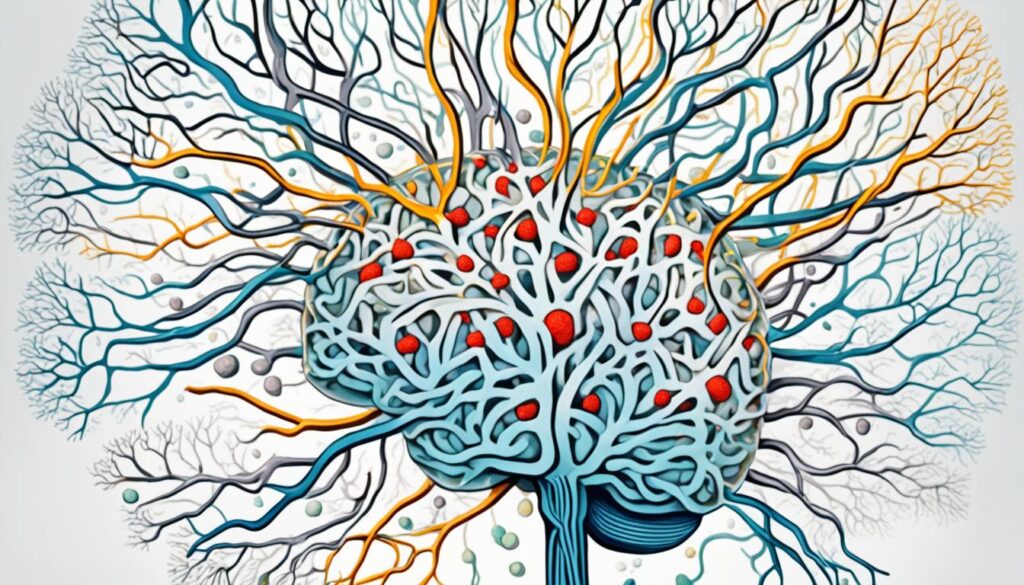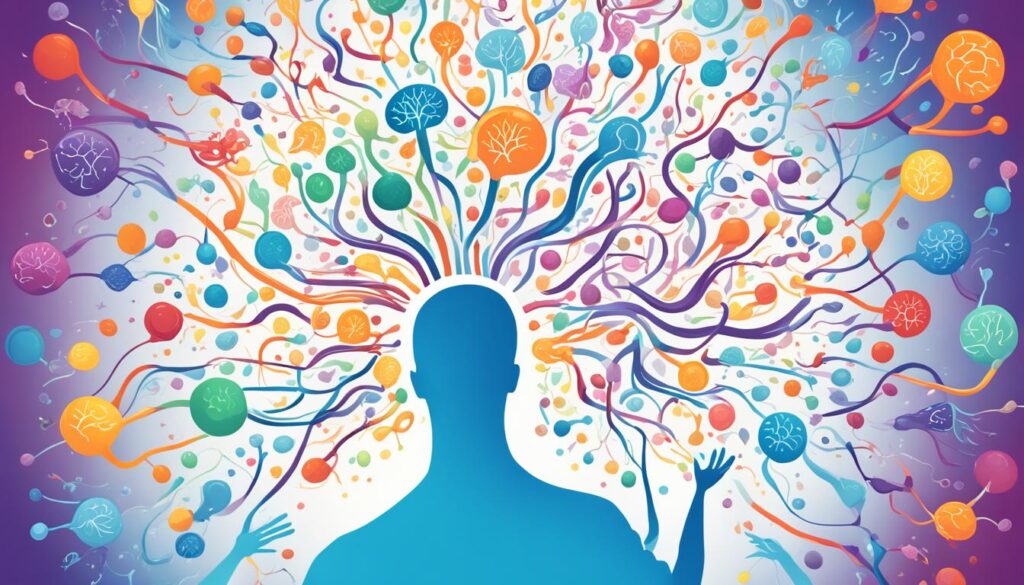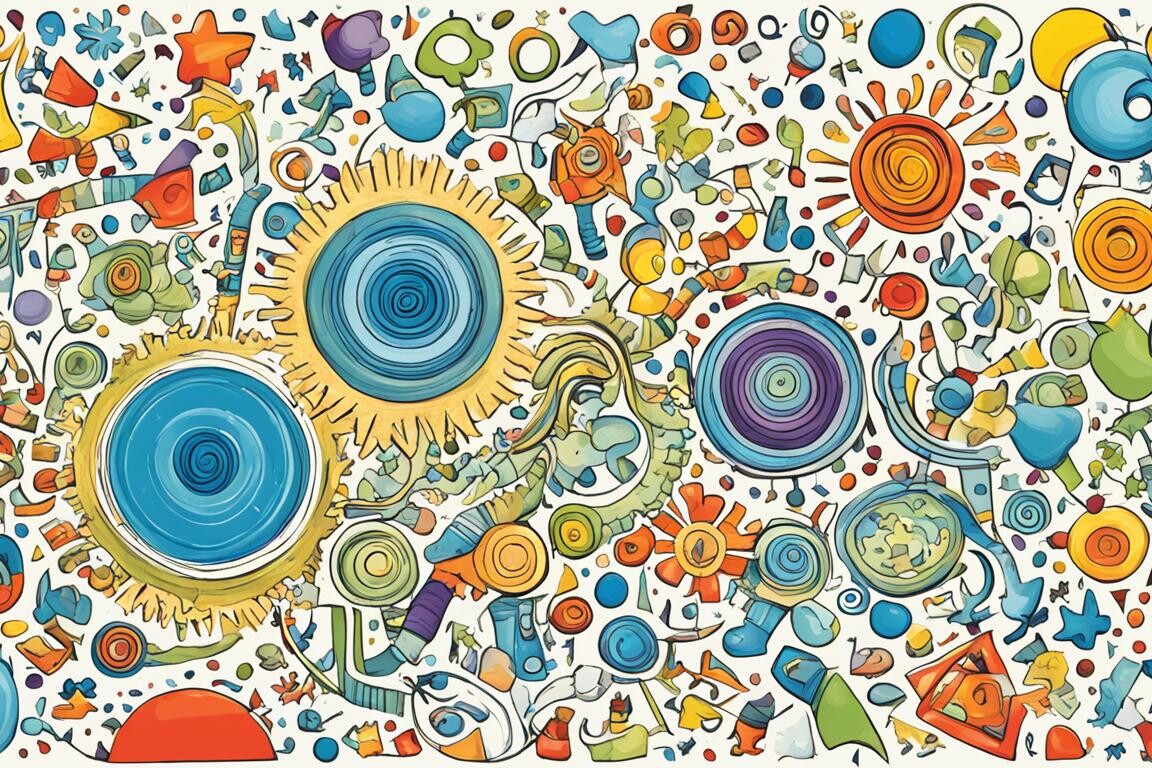Welcome to a comprehensive exploration of the causes of autism, where we delve into the latest insights and research surrounding this complex neurodevelopmental condition. Autism affects social interactions, communication skills, and behavior, posing unique challenges for individuals and their families. By understanding the underlying causes, we can enhance our ability to diagnose and treat autism effectively.
Research has shed light on various factors associated with autism, encompassing genetic variants, environmental influences, and neurological differences. These insights have paved the way for further investigation and have enabled us to develop more targeted approaches to diagnosis and intervention.
Throughout this article, we will explore the multifaceted aspects of autism, including the role of genetic factors, environmental influences, and neurological underpinnings. We will also examine the advances made in the diagnosis and treatment of autism, as well as the prevalence rates across different cultures. Additionally, we will discuss the importance of advocacy, public awareness, and the future of autism research and support.
Join us as we embark on this insightful journey, deepening our understanding of autism and paving the way for a more inclusive society for individuals with autism spectrum disorder.
Table of Contents
ToggleGenetic Factors and Autism
Research has shown that genetic factors play a significant role in the development of autism spectrum disorder (ASD). Studies conducted by De Rubeis et al. (2014) have provided valuable insights into the genetic basis of autism. For example, research on twins has demonstrated a high heritability rate for ASD, indicating that genetic factors contribute to its occurrence. Concordance rates were found to be higher in identical twins compared to fraternal twins, further emphasizing the role of genetics in ASD.
In a study by Bernier et al. (2014), specific gene variants associated with autism were identified. These gene variants provide valuable clues about the biological mechanisms underlying autism and can also serve as potential targets for further research and personalized treatments.
To provide a better understanding of the genetic factors involved in autism, here is a table summarizing key findings from relevant studies:
| Study | Key Findings |
|---|---|
| De Rubeis et al. (2014) | High heritability rate for autism, concordance rates higher in identical twins. |
| Bernier et al. (2014) | Identification of specific gene variants associated with autism. |
Understanding the impact of genetic factors on autism is crucial for developing targeted interventions and personalized treatment strategies. Further research in this area will continue to deepen our understanding of the complex interplay between genetic variants and autism spectrum disorder.
Environmental Factors and Autism
Research has shown that environmental factors, in addition to genetic factors, can contribute to the development of autism spectrum disorder. Prenatal exposure to certain environmental influences has been associated with an increased risk of autism in children.
One significant environmental factor that has been studied is prenatal infections. Maternal infections during pregnancy, such as influenza, have been found to be linked to a higher likelihood of autism in the offspring. These infections can disrupt the delicate developmental processes in the brain, potentially leading to autism spectrum disorder.
Exposure to air pollutants is another environmental factor that has been identified as a potential risk factor for autism. Studies have found associations between exposure to substances like ozone and particulate matter and an increased risk of autism in children. It is believed that these pollutants can affect brain development and contribute to the manifestation of autism spectrum disorder.
Understanding the interaction between environmental factors and genetic vulnerabilities is essential for comprehending the complexity of autism. By recognizing and addressing these environmental influences, we can potentially reduce the risk and improve the lives of individuals with autism spectrum disorder.
To further illustrate the impact of environmental factors on autism, consider the following table:
| Environmental Factor | Associated Risk |
|---|---|
| Prenatal infections | Elevated likelihood of autism in offspring |
| Air pollutants | Higher risk of autism |

Gut Microbiome and Autism
Growing evidence suggests a potential link between imbalances in the gut microbiome and autism. The gut microbiome refers to the collection of microorganisms, including bacteria, fungi, and viruses, residing in the digestive tract.
Research studies have explored the role of the gut microbiome in autism spectrum disorder (ASD) and have found intriguing connections. Imbalances in the gut microbiota have been associated with gastrointestinal symptoms commonly experienced by individuals with autism, such as abdominal pain, constipation, and diarrhea. Furthermore, disturbances in the gut microbiome have been linked to the presence of autism-related behaviors, including social communication challenges and repetitive behaviors.
Microbiota transfer therapy (MTT), also known as fecal microbiota transplantation (FMT), has emerged as a potential treatment approach for individuals with autism. MTT involves transferring the gut microbiota from a healthy individual to a person with ASD, aiming to restore a healthy microbial balance. Preliminary studies have shown promising results, including improvements in gastrointestinal symptoms and behavioral outcomes.
The Gut-Brain Connection
One theory suggests that the communication between the gut and the brain, known as the gut-brain axis, plays a significant role in the development and manifestation of autism. The gut microbiome influences various aspects of brain function, including neurotransmitter production and inflammation regulation. Imbalances in the gut microbiota may disrupt this delicate balance and contribute to the neurological differences observed in individuals with autism.
Recent research has highlighted the potential interaction between genes and the gut microbiome in autism. Studies have identified specific gene variations that affect the composition and diversity of the gut microbiota. These findings highlight the complex interplay between genetic factors and the gut microbiome in autism development.
The Role of Diet and Probiotics
Investigations into the gut microbiome and autism have also explored the impact of diet on gut health and autism-related symptoms. Certain dietary interventions, such as eliminating gluten and casein or following a specific carbohydrate diet (SCD), have shown potential benefits in reducing gastrointestinal problems and improving behavior in some individuals with autism.
Probiotics, which are beneficial bacteria, have been studied for their potential to restore a healthy gut microbiome and alleviate autism-related symptoms. Research on the effectiveness of probiotics in autism is ongoing, with some studies suggesting positive outcomes in areas such as social interaction, communication, and repetitive behaviors.
| The Gut Microbiome and Autism | Key Findings |
|---|---|
| Imbalances in the gut microbiome | Associated with gastrointestinal symptoms and autism-related behaviors |
| Microbiota Transfer Therapy (MTT) | Shows potential in improving gastrointestinal symptoms and behavioral outcomes |
| Gut-brain axis | Contributes to the communication between the gut and the brain, influencing autism development |
| Diet and probiotics | Play a role in supporting a healthy gut microbiome and reducing autism-related symptoms |
Neurological Factors and Autism
Investigations into neurological factors associated with autism have revealed interesting findings. Neurological differences play a crucial role in the development of autism spectrum disorder (ASD), contributing to the characteristic symptoms and challenges faced by individuals on the autism spectrum.
One intriguing aspect is the potential impact of myelin integrity on autism. Myelin, a protective sheath surrounding nerve cells, is essential for efficient communication between neurons. Studies have shown that individuals with autism often exhibit a decrease in myelin integrity, which may disrupt brain development and impair neural connectivity.
Research is ongoing to understand the precise mechanisms underlying this malfunction in myelin production and its relationship to autism. By exploring neurological factors, scientists hope to uncover ways to enhance myelination and improve autism-associated behaviors.
Furthermore, other neurological factors such as atypical brain connectivity patterns and alterations in brain structure have also been observed in individuals with ASD. These factors contribute to the unique cognitive and behavioral characteristics of autism.
A better understanding of the neurological factors associated with autism holds promise for the development of targeted interventions and treatments. By addressing the root causes, researchers aim to enhance the overall well-being and quality of life for individuals with autism spectrum disorder.

Advances in Diagnosis and Biomarkers
Early diagnosis is crucial for effectively managing autism spectrum disorder (ASD). Researchers are making significant strides in developing innovative diagnostic methods and identifying biomarkers that can aid in early detection. These advancements have the potential to greatly improve outcomes for individuals with autism.
Diagnostic Methods
One promising diagnostic method being explored is the use of auditory brainstem response (ABR) hearing tests. These tests measure the brain’s electrical activity in response to sound, allowing clinicians to assess auditory processing and identify potential signs of autism. ABR testing shows promise in detecting early indicators of ASD, enabling early intervention and targeted therapies.
Biomarkers and Metabotypes
Another area of research focuses on identifying biomarkers and metabotypes associated with autism. Biomarkers are measurable indicators in the body that can signify the presence or progression of a disorder. Metabotypes, on the other hand, are unique metabolic profiles observed in individuals with autism.
By identifying specific biomarkers and metabotypes, researchers aim to develop screening tests that can aid in early diagnosis and intervention. These tests could be non-invasive and easy to administer, enabling healthcare professionals and parents to identify potential signs of autism at an early stage. Early identification and intervention can lead to more effective treatment strategies and improved long-term outcomes for individuals with autism.
| Biomarker | Significance |
|---|---|
| Metabolic alterations | Associated with autism spectrum disorder |
| Neurotransmitter imbalances | Potential biomarkers for autism |
| Oxidative stress markers | Implicated in the pathogenesis of autism |
| Immune system dysregulation | Linked to autism spectrum disorder |
*Please note that the table above provides examples and is not an exhaustive list of biomarkers associated with autism.
These advancements in diagnosis and the identification of biomarkers offer hope for improved understanding, early intervention, and personalized treatment for individuals with autism. Continued research in this field will pave the way for a more comprehensive and accurate diagnostic process, providing individuals with autism the support they need to thrive.
Evolution of Understanding and Treatment Approaches
The understanding of autism has evolved significantly over time. From early misconceptions and the false “refrigerator mother” theory to current neurological and genetic perspectives, our understanding of autism has become more nuanced.
Treatment approaches for autism have also progressed, aiming to improve the quality of life for individuals with autism. One commonly used approach is Applied Behavioral Analysis (ABA), which focuses on reinforcing positive behaviors and reducing challenging ones. ABA interventions can be tailored to address specific goals, such as improving communication skills or reducing repetitive behaviors.
In addition to ABA, holistic therapies have gained recognition as complementary treatment options for autism. These therapies take into account the individual’s overall well-being, including their physical, emotional, and social needs. Examples of holistic approaches include art therapy, music therapy, and sensory integration therapy.
The neurodiversity movement has played a significant role in changing societal perceptions of autism. This movement emphasizes the acceptance and inclusion of neurodiverse individuals, recognizing autism as a natural variation of human neurology rather than a disorder to be cured. By embracing the principles of neurodiversity, society can create a more inclusive environment that celebrates the unique strengths and perspectives of individuals with autism.
History of Autism
The history of autism dates back to the early 20th century when it was first recognized as a distinct condition. In 1943, psychiatrist Leo Kanner published a groundbreaking paper describing a group of children with unique social and communication difficulties. This marked the beginning of autism research and the identification of autism as a separate condition.
In the 1960s and 1970s, a controversial theory known as the “refrigerator mother” theory emerged, suggesting that autism was caused by emotional coldness and lack of maternal warmth. This theory has since been discredited, and it is now widely understood that autism has a complex interplay of genetic, environmental, and neurological factors.
Over the years, advancements in research have deepened our understanding of autism. Genetic studies have identified specific gene variants associated with autism, providing insights into the underlying biology of the condition. Neurological research has revealed differences in brain structure and connectivity in individuals with autism, further contributing to our understanding of the condition.
It is important to note that the history of autism is marked by changing diagnostic criteria and evolving terminology. The diagnostic criteria for autism have undergone revisions, leading to changes in how autism is diagnosed and classified. The most recent edition of the Diagnostic and Statistical Manual of Mental Disorders (DSM-5) includes the diagnosis of Autism Spectrum Disorder (ASD) as a single category encompassing various levels of symptom severity.
Treatment Approaches
Over the years, various treatment approaches have been developed to support individuals with autism. These approaches aim to address the core symptoms of autism, such as social and communication challenges, and enhance overall functioning and quality of life.
Applied Behavioral Analysis (ABA) is one of the most widely used and researched treatment approaches for autism. ABA focuses on using positive reinforcement to teach and encourage desired behaviors while reducing challenging ones. This approach is often utilized in early intervention programs and can be highly individualized to meet the specific needs of each person with autism.
Holistic therapies have also gained popularity as complementary treatments for autism. These therapies take a comprehensive approach, considering the physical, emotional, and social well-being of individuals with autism. Examples of holistic therapies include art therapy, music therapy, animal-assisted therapy, and sensory integration therapy. These approaches often aim to improve sensory integration, emotional regulation, and social skills.
Table: Comparative Overview of Treatment Approaches
| Treatment Approach | Description | Benefits |
|---|---|---|
| Applied Behavioral Analysis (ABA) | Uses behavioral principles to teach and reinforce desired skills while reducing challenging behaviors. | Individualized interventions, measurable outcomes, evidence-based. |
| Speech-Language Therapy | Targets communication and language skills, including speech production, comprehension, and social communication. | Improves communication abilities, enhances social interactions. |
| Occupational Therapy | Helps individuals develop skills for daily living, fine motor coordination, sensory processing, and self-regulation. | Enhances independent living, sensory integration, self-care abilities. |
| Physical Therapy | Focuses on improving physical mobility, coordination, balance, and strength through therapeutic exercises. | Enhances motor skills, promotes physical fitness. |
While there is no cure for autism, early intervention and appropriate treatment can significantly improve outcomes for individuals with autism. The effectiveness of treatment approaches may vary depending on individual needs and preferences. It is important for caregivers and professionals to work together to develop personalized treatment plans that address the unique strengths and challenges of each individual with autism.

Prevalence and Cultural Perspectives of Autism
Autism prevalence rates vary globally, influenced by a combination of genetic and environmental factors, as well as cultural perspectives and diagnostic criteria. It is important to consider the impact of cultural differences on the diagnosis and perception of autism, as they can contribute to underdiagnosis or misdiagnosis in certain societies. A deeper understanding of cultural influences is crucial for ensuring accurate diagnosis and providing appropriate support for individuals with autism.
In some cultural contexts, the characteristics associated with autism may be perceived differently or interpreted as normal behavior, leading to challenges in recognizing and addressing the condition. Cultural beliefs, attitudes, and social norms surrounding developmental differences and disabilities can significantly impact the identification and acceptance of autism.
For example, in some societies where collective harmony and conformity are emphasized, individuals with autism may be expected to conform to social norms, leading to their differences being overlooked or misunderstood. Additionally, cultural stigmas and misconceptions surrounding autism can further contribute to underdiagnosis and hinder access to necessary resources and support.
To address the underdiagnosis of autism in different cultural contexts, it is essential to promote cross-cultural awareness, knowledge, and sensitivity among healthcare professionals, educators, and communities. By recognizing and valuing diverse cultural perspectives, we can improve early identification and interventions for individuals with autism, ensuring that their unique needs are met.
Challenges in Cultural Assessment and Diagnosis
Cultural perspectives play a significant role in shaping autism diagnosis, evaluation, and treatment, as they influence the interpretation and understanding of developmental differences. However, cultural biases and stereotypes can pose challenges in accurately assessing and diagnosing autism.
- Cultural variations in the expression of autism symptoms: The presentation and severity of autism symptoms may vary across cultures, making it crucial to account for cultural differences when evaluating individuals.
- Language barriers: Language differences can impact the assessment process, as communication difficulties associated with autism may be mistaken for language barriers. Culturally sensitive assessments should consider the use of interpreters or culturally relevant communication tools.
- Stigma and cultural beliefs: Cultural stigmas associated with disabilities, including autism, can hinder disclosure and awareness of developmental differences. Addressing these stigmas and fostering open dialogue is essential for accurate diagnosis and support.
Promoting Cultural Understanding and Inclusive Practices
Improving cultural competence and inclusivity in autism diagnosis and support requires collaboration and education at multiple levels. Here are some strategies to promote cultural understanding and ensure equitable access to services:
- Training healthcare professionals and educators: Providing training on cultural competence and autism in diverse cultural contexts equips professionals with the knowledge and skills necessary to recognize and address the unique needs of individuals with autism.
- Engaging with multicultural communities: Building partnerships with cultural and community organizations can help increase awareness, reduce stigma, and facilitate outreach efforts in underserved communities.
- Developing culturally sensitive assessment tools: The development of assessment tools that consider cultural variations in the presentation of autism symptoms can improve diagnostic accuracy and reduce underdiagnosis.
- Promoting inclusive practices in education: Creating inclusive learning environments that embrace diverse cultural perspectives fosters acceptance and understanding of individuals with autism.
Awareness and understanding of both the prevalence and cultural perspectives of autism are vital for ensuring accurate diagnosis, appropriate support, and inclusive practices. By acknowledging and addressing cultural influences, we can create a society that celebrates and supports the diverse experiences of individuals with autism.
Advocacy and Public Awareness
Advocacy groups play a vital role in promoting autism advocacy and raising public awareness about autism spectrum disorder. These organizations, such as Autism Speaks and the Autism Society, work tirelessly to advocate for the rights and needs of individuals with autism. By organizing events, launching campaigns, and providing resources, these groups ensure that the voices of the autism community are heard.
One powerful way of increasing public awareness about autism is through the medium of film. One notable example is the movie “Rain Man,” which depicted the unique perspective and challenges faced by individuals with autism. This critically acclaimed film helped bring autism into the mainstream consciousness and fostered greater understanding among the general public.
Another symbol that has become synonymous with autism advocacy and awareness is the Autism Awareness Puzzle Ribbon. This iconic symbol represents the complexity and diversity of individuals with autism and serves as a powerful reminder to embrace neurodiversity. By wearing the Autism Awareness Puzzle Ribbon, individuals show their support and solidarity with the autism community.
Furthermore, the neurodiversity movement has emerged as a powerful force in autism advocacy. This movement, driven by self-advocacy, aims to shift the focus from seeing autism as a disorder that needs to be cured to recognizing and celebrating the unique strengths and perspectives of individuals on the autism spectrum. The neurodiversity movement advocates for acceptance, inclusion, and the right to be treated with respect and dignity.

| Advocacy Groups | Mission |
|---|---|
| Autism Speaks | To promote solutions, across the spectrum and throughout the life span, for the needs of individuals with autism and their families through advocacy and support, increasing understanding and acceptance of people with autism, and advancing research into causes and better interventions for autism spectrum disorder. |
| Autism Society | To promote lifelong access and opportunities for persons within the autism spectrum and their families to be fully included, participating members of their communities through advocacy, public awareness, education, and support. |
The Future of Autism Research and Support
Ongoing research in the field of autism aims to uncover new insights into the causes, diagnosis, and treatment of this complex condition. As our understanding of autism deepens, exciting advancements in genetic analysis, neurological studies, and biomarker identification pave the way for personalized treatment approaches.
With advancements in technology, researchers can now analyze genetic variations and identify specific markers associated with autism spectrum disorder (ASD). This research not only enables accurate diagnosis but also opens doors to targeted therapies tailored to the unique needs of individuals with autism.
Neurological studies have provided valuable insights into the intricacies of brain functions in individuals with autism. Through advanced imaging techniques, researchers have observed structural and functional differences that contribute to the challenges experienced by individuals with ASD. These findings aid in the development of innovative treatment strategies focused on enhancing brain connectivity and improving social and communication skills.
Personalized Treatment Approaches
The future of autism research is centered around personalized treatment approaches that take into account the unique characteristics of each individual with autism. By considering factors such as genetics, neurological profiles, and co-occurring conditions, researchers and healthcare professionals can develop tailored interventions that address specific challenges and promote optimal development and well-being.
Implementing personalized treatment approaches involves a multidisciplinary approach, with collaboration between healthcare providers, therapists, educators, and caregivers. This holistic approach aims to create a comprehensive support system that addresses the diverse needs of individuals with ASD and helps them reach their full potential.
Creating an Inclusive Society
Building an inclusive society is crucial for supporting individuals with autism and ensuring they have equal access to opportunities, resources, and acceptance. It requires the collective efforts of policymakers, communities, and individuals to create an environment that embraces neurodiversity and values the unique contributions of individuals with autism.
An inclusive society promotes understanding, empathy, and accommodates the diverse needs of individuals with autism. Through education, awareness campaigns, and advocacy, we can challenge stigmas, promote acceptance, and foster a sense of belonging for individuals with autism.
The Role of Future Research, Advocacy, and Policy Changes
The future of autism research and support lies in continued exploration, discovery, and implementation of evidence-based practices. Ongoing research efforts focusing on the genetic, environmental, and neurological aspects of autism will provide further insights, leading to advancements in early detection, intervention, and improved outcomes for individuals with ASD.
Advocacy plays a vital role in raising public awareness, generating research funding, and driving policy changes to ensure individuals with autism receive the support they need. By amplifying the voices of individuals with ASD and their families, we can drive societal change and create a more inclusive and supportive environment.
In conclusion, the future of autism research and support holds great promise. Through personalized treatment approaches, an inclusive society, and the continued dedication of researchers, advocates, and policymakers, we can enhance the lives of individuals with autism and create a more inclusive and compassionate world.
Conclusion
In conclusion, autism spectrum disorder (ASD) is a complex condition influenced by a combination of genetic, environmental, and neurological factors. The advancements in research have significantly deepened our understanding of autism, improving our ability to diagnose and treat individuals with ASD.
However, beyond diagnosis and treatment, it is crucial to foster societal acceptance, support, and inclusion for individuals with autism. Embracing the principles of neurodiversity, we must recognize the unique strengths and challenges of individuals with autism and create an inclusive society that celebrates their diversity.
Continued research, advocacy, and education are essential in further advancing our understanding of autism and developing effective support systems. By investing in resources and initiatives that promote awareness, acceptance, and accessibility, we can create a more inclusive world for individuals with autism and their families.
FAQ
What are the causes of autism?
Autism is influenced by a combination of genetic, environmental, and neurological factors. Genetic variants, environmental exposures, and differences in brain development all contribute to the development of autism.
Do genetics play a role in autism?
Yes, research has shown that genetic factors play a significant role in the development of autism. Studies on twins have revealed a high heritability rate for autism, and the identification of specific gene variants has further contributed to our understanding of the genetic basis of autism.
What environmental factors are associated with autism?
Environmental factors such as prenatal infections, exposure to toxins, and air pollution have been linked to an increased risk of autism. Maternal infections during pregnancy, like influenza, and exposure to air pollutants like ozone and particulate matter, have been found to be associated with a higher likelihood of autism in offspring.
How does the gut microbiome relate to autism?
Growing evidence suggests a potential link between imbalances in the gut microbiome and autism. Studies have shown that balancing the populations of gut microbes can lead to improvements in gastrointestinal symptoms and autism-related behaviors. There is also a connection between genes and the gut microbiome, highlighting the role of the microbiome in autism development.
What neurological factors are associated with autism?
Studies have shown a decrease in the integrity of myelin, a protective sheath surrounding nerve cells, in individuals with autism. This malfunction in myelin production may disrupt brain development and impair communication between nerve cells, contributing to the characteristic symptoms of autism.
Are there advancements in autism diagnosis?
Yes, researchers are exploring innovative diagnostic methods for autism, such as auditory brainstem response (ABR) hearing tests and the identification of metabotypes associated with autism. These advancements have the potential to provide earlier and more accurate diagnosis of autism.
How has the understanding and treatment of autism evolved?
Our understanding of autism has evolved significantly over time, from early misconceptions to current neurological and genetic perspectives. Treatment approaches, such as Applied Behavioral Analysis (ABA) and holistic therapies, aim to improve the quality of life for individuals with autism. The neurodiversity movement has also contributed to changing societal perceptions and promoting acceptance and inclusion of neurodiversity.
How prevalent is autism, and how is it perceived in different cultures?
Prevalence rates of autism vary globally, influenced by genetic and environmental factors, as well as cultural perspectives and diagnostic criteria. Cultural differences can impact the diagnosis and perception of autism, leading to underdiagnosis or misdiagnosis in certain societies. Awareness and understanding of cultural influences are essential for accurate diagnosis and appropriate support.
What role do advocacy groups play in supporting individuals with autism?
Advocacy groups such as Autism Speaks and the Autism Society play key roles in raising awareness, promoting research funding, and advocating for the rights and needs of individuals with autism. Films like “Rain Man” and symbols like the Autism Awareness Puzzle Ribbon have also contributed to increased public awareness.
What does the future hold for autism research and support?
Ongoing research aims to uncover further insights into the causes, diagnosis, and treatment of autism. Advances in genetic analysis, neurological studies, and biomarker identification hold promise for personalized treatment approaches. Creating an inclusive society that supports the unique needs and strengths of individuals with autism is a collective responsibility.
About The Author

This article is medically reviewed by Dr. Chandril Chugh, Board-Certified Neurologist, providing expert insights and reliable health information.
Dr. Chandril Chugh is a U.S.-trained neurologist with over a decade of experience. Known for his compassionate care, he specializes in treating neurological conditions such as migraines, epilepsy, and Parkinson’s disease. Dr. Chugh is highly regarded for his patient-centered approach and dedication to providing personalized care.
→ Book a consultation to discover which remedies suit your needs best.




